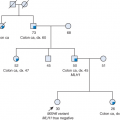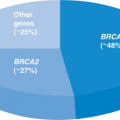Genetic Testing by Cancer Site: Colon (Nonpolyposis Syndromes)
Leigha Senter
Approximately 5% to 10% of colorectal cancers (CRCs) are hereditary and are often categorized by the presence or absence of polyposis as a predominant feature. Lynch syndrome (LS), also sometimes referred to as hereditary nonpolyposis CRC, is the most common form of hereditary CRC, accounting for approximately 2.2%1 of population-based CRC diagnosed in the United States. LS also accounts for 2.3%2 of all newly diagnosed endometrial cancers (ECs), and individuals with LS also have an increased risk of developing other cancers, including cancers of the ovary, stomach, small bowel, urothelium, and biliary tract.3 Given these increased cancer risks, cancer screening recommendations for individuals with LS differ significantly from general population screening recommendations with a goal of reducing cancer risk and burden to the extent possible.
Mutations in 1 of 4 mismatch repair genes (MLH1, MSH2, MSH6, and PMS2) cause LS, and clinical genetic testing is available for all of them. Unlike most other hereditary cancer syndromes, though, clinical testing for LS typically begins with microsatellite instability (MSI) testing and/or immunohistochemical (IHC) staining of tumor tissue before germline genetic testing. This difference in testing approach, although not always possible, allows for targeted genetic analysis and, in most cases, reduced cost. Here, we review key considerations in genetic counseling for LS.
Cancer Risks
CRC and EC are the two most common LS-associated malignancies, and there have been several calculations of lifetime cancer risks reported in the literature. Differences in ascertainment and testing approaches have led not only to wealth of data but also to a wide range of risk estimates for consideration by clinicians and patients. Consistently, studies have found that the lifetime CRC risk for men with LS is higher than the risk for women with LS. The lifetime CRC for males is 27% to 92%, whereas the risk for females is 22% to 68%.4,5 The most recent large study of carriers of MLH1, MSH2, and MSH6 mutations estimated lifetime CRC risks for males and
females to be 38% and 31%, respectively.6 The average age at CRC diagnosis tends to be younger in LS (estimated 45 to 59 years) than that in the general population.6,7 The lifetime risk of EC for women with LS based on recent data is estimated to be 33% to 39%.6,8 Individuals with LS who have already been diagnosed with CRC also have an increased risk (10-year risk of 16%) of developing a second primary CRC.9
females to be 38% and 31%, respectively.6 The average age at CRC diagnosis tends to be younger in LS (estimated 45 to 59 years) than that in the general population.6,7 The lifetime risk of EC for women with LS based on recent data is estimated to be 33% to 39%.6,8 Individuals with LS who have already been diagnosed with CRC also have an increased risk (10-year risk of 16%) of developing a second primary CRC.9
In addition to sex differences in LS-associated cancer risks, there appear to be some differences in gene-specific–associated cancer risks, as well. MLH1 and MSH2 seem to be associated with a higher overall cancer risk than risks associated with MSH6 or PMS2.10,11 Variable expression of phenotype both within and among families with LS is common. Therefore, as a general rule, management of families with LS (discussed later) should always take into account the family history.
Malignancies of the ovary, stomach, small bowel, urothelium, and biliary tract are also seen with greater frequency in individuals with LS when compared with the general population. Although cumulative risk estimates of these less common tumor types have been published, they are usually based on fewer cases than studies focused on CRC and EC, and have typically shown a lifetime cancer risk of less than 10%.3 There have also been reports of LS-associated pancreatic and breast cancers, but the data have been inconsistent. A recent prospective study showed an increased risk of developing both tumor types when comparing carriers of MMR gene mutations to their unaffected relatives.12 Additional data are necessary, however, to determine whether screening recommendations should change based on these reported risks.
Some individuals with LS also have a predisposition to developing sebaceous lesions and keratoacanthomas of the skin. When an individual has one of these lesions in addition to a visceral organ malignancy, they have a variant of LS called Muir–Torre syndrome.13 Some recent studies suggest that these skin lesions are more common in LS than originally thought and that sebaceous tumors of the skin should be considered part of the typical LS spectrum.14
Another variant of LS characterized by the presence of glioblastomas is called Turcot syndrome. Turcot syndrome is more commonly caused by mutations in the APC gene but has been described in individuals with MMR deficiency, as well.15
Clinical Classification: Amsterdam Criteria and Bethesda Guidelines
In 1991, the International Collaborative Group on Hereditary Non-Polyposis CRC wrote the Amsterdam I criteria16 and revised them in 1999 (Amsterdam II criteria)17 to clinically classify families as having LS (Table 8.1). The Amsterdam criteria rely heavily on extensive family history and do not take into account the full spectrum of possible LS-associated tumors. The less stringent Bethesda guidelines (written in 1997 and revised in 2004)18,19 (Table 8.2) were written to include these less common LS-associated tumors as well as pathologic features that are common in LS-associated CRCs. Unlike the Amsterdam criteria, which were meant to diagnose LS based on familial criteria, the Bethesda guidelines were meant to determine who should have
tumor screening for LS and relied less on family history. It has been repeatedly shown, however, that these clinical classification systems do not reliably predict LS in all patient populations, particularly those outside the cancer genetics clinics dedicated to high-risk patients.1,20
tumor screening for LS and relied less on family history. It has been repeatedly shown, however, that these clinical classification systems do not reliably predict LS in all patient populations, particularly those outside the cancer genetics clinics dedicated to high-risk patients.1,20
Table 8.1 Revised Amsterdam Criteria | ||
|---|---|---|
|
Table 8.2 Revised Bethesda Guidelines | |
|---|---|
|






